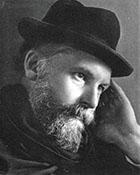Telepathy

Frederic Myers first used the word "telepathy" in December 1882 in the first volume of the journal of the Society for Psychical Research. Myers wrote,"..."we venture to introduce the words Telasthesia and Telepathy to cover all cases of impression received at a distance." 1, 4, 5 Since then, telepathy has continued to be a subject of interest and investigation.
Although the word telepathy wasn't coined until 1882, the idea that it is possible to transfer thoughts from one being to another has been in existence since ancient times and is common to many cultures. Some native cultures, such as the Aborigines of Australia, accept telepathy as a natural part of human existence3.
At the founding of the American Society for Psychical Research, telepathy was the first subject to be investigated through experiment. As described by R. Osgood Mason4, the report was "a description of various experiments undertaken... to determine... whether one person or one mind can receive impressions or intelligence from another person or mind without communication by word, touch, or sign or by any means whatsoever apart from the ordinary and recognized methods of perception or the ordinary channels of communication."
To define telepathy, Mason goes on to describe "The Willing Game," a popular "common amusement" played at social gatherings. In the game, the group elects one person to leave the room and in the person's absence, the rest of the group appoints a task for the person, such as finding a hidden object or moving something (e.g. a book, a candle, etc) from one place to another. Then the "willed" person returns to the room, the game leader places one hand lightly on his/her shoulder or arm while the rest of the company concentrates on the task. The game is considered successful if the subject quickly accomplishes his or her mission.
First scientific investigations in telepathy often mirrored such social diversions. Mason categorized telepathic experiments in four classes:
- Like the Willing Game, an experiment in which a prearranged task is accomplished with personal contact maintained between the operative (sender) and the sensitive (receiver).
- Those where a prearranged task was set with no personal contact between operative and sensitive.
- Where the sensitive ascertains a name, number, or card without using any of the ordinary channels of communication.
- Where two or more people convey the same impressions or have the same ideas although widely separated from each other.

Later, investigative protocols became stricter. Among the most well known telepathic experiments were those conducted by J.B. Rhine, using Zener cards. Rhine's experiments popularized the term Extra Sensory Perception (ESP). Instead of using subjects who claimed to have telepathic ability, Rhine chose his subjects more or less at random to better evaluate the outcome of his experiments3, 5.
Freud theorized that telepathy may have been a form of ancient communication turned physical and conversely that it was a physical process that, over time, became mental. Although Freud cautioned other peers, such as Carl Jung and Sándor Ferenczi, against being too public in expressing their opinions on telepathy (lest they harm the reputation of psychoanalysis), his interest in the subject was personal. Freud believed that he had communicated remotely with his fiancée, Martha, when he was in Paris. Freud decried the use of mediums and approached the study of telepathy only on scientific terms. Although his later experiments were unsuccessful, he continued to believe that telepathy was a probable occurrence, even if not demonstrable6.
Telepathy continues to be the main subject of of parapsycholigical research, often funded by research councils to try to either prove or disprove scientific claims or counter claims.
However, interest in telepathy has never been confined to the scientific community. In 1930, author Upton Sinclair published "Mental Radio", a book about his wife's ability to reproduce his drawings and those of others when separated by several miles. Numerous Science Fiction media use telepathy as an integral part of their plot lines. For instance, telepathy was used in several episodes of Star Trek and also by the Jedi in the Star Wars movies. In the 1978 movie, Superman, as they fly through the air, Lois Lane wonders, "Can you read my mind? Can you picture the things I'm thinking of?"
Moreover, public interest and belief in telepathy has never waned. Many family members believe they have the ability to sense when another family member is ill, in trouble, or near death (e.g. Mother's intuition). Twins often believe they are telepathic with each other and there are those who believe that telepathy goes beyond human to human. For instance, in a recent airing on Animal Planet's television program, "Extraordinary Animals", members and staff of a nursing home believe the resident dog can "sense" impending death.
2. Douglas Harper. “Telepathy.” Online Etymology Dictionary. 2001. 15 Jun 2008 <http://www.etymonline.com/>.
3. Alan G. Hefner. “Telepathy.” The Mystica 12 Jun 2008. 20 Jul 2008 <http://www.themystica.com/mystica/articles/t/telepathy.html>.
4. R. Osgood Mason. Telepathy and the Subliminal Self. New York: Henry Holt and Company, 1899. 20 Jul 2008 <http://books.google.com/books?id=2dgRAAAAYAAJ&printsec=titlepage&dq=telepathy&source=gbs_summary_r&cad=0>.
5. Ellie Crystal. “Telepathy.” Crystalinks n.d . 20 Jul 2008 <http://www.crystalinks.com/telepathy.html>.
6. Sophie De Mijolla-Mellor. “Telepathy.” Ed. Alain de Mijolla, Gale Cengage. International Dictionary of Psychoanalysis (2005). 20 Jul 2008 <http://www.enotes.com/psychoanalysis-encyclopedia/telepathy>.
